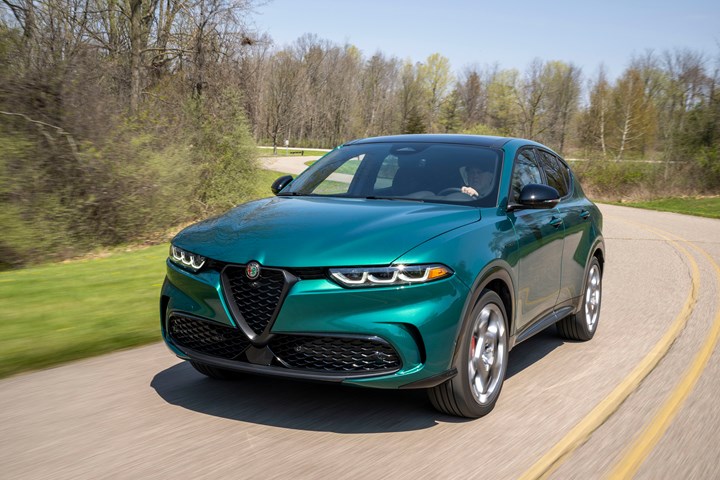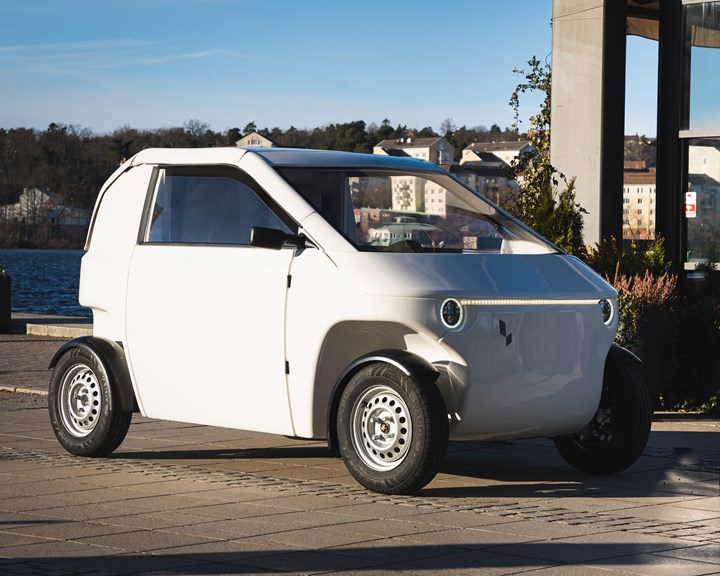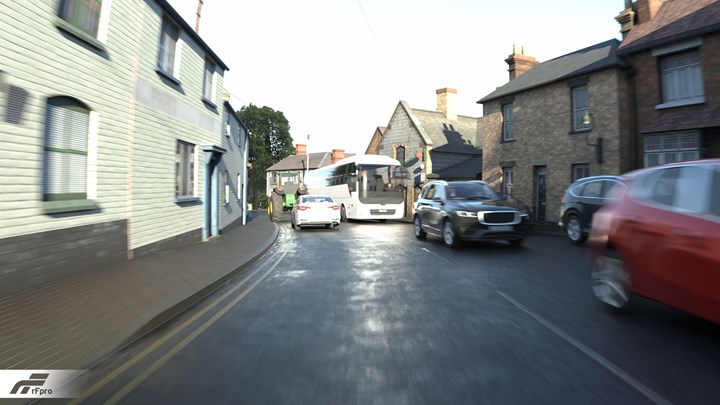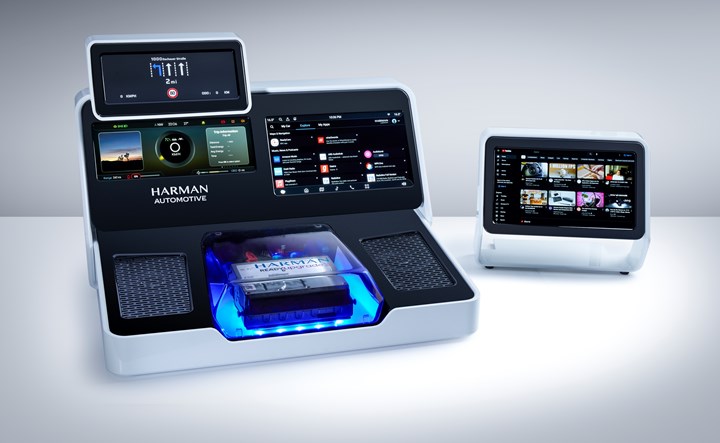on Tonale, simulating, assembling, & advanced digital tech
An impressive PHEV from Alfa Romeo. . .an EV designed to ship like an IKEA desk. . .advancing simulation for ADAS. . .remarkable adhesive accuracy. . .Harman’s suite of non-audio tech. . .Bosch on software. . .
About the 2024 Alfa Romeo Tonale

2024 Alfa Romeo Tonale: a compact crossover with a PHEV powertrain across the lineup. (Image: Alfa Romeo)
Alfa Romeo is a Stellantis brand that is probably not as well-known as it ought to be in the U.S. market. That is, through the first quarter of 2023, there were a total 2,390 Alfas delivered, of which 1,424 were the Stelvio crossover. The remaining 966 were the Giulia sedan.
To put that 2,390 into some context, know that during Q1 ’23 there were 2,986 Chrysler 300 sedans delivered, and that second generation of the contemporary 300 was introduced in model year 2011, with a refresh in MY 2014. Not exactly the sort of thing that people are clamoring for.
Italia
But Alfa is a brand with resonance in Italy, as it was established there in 1910 (which makes it older than Chevrolet in the U.S., which was founded in 1911), so the just-introduced Tonale, which was styled in Italy and is being produced at the Giambattista Vico Stellantis plant in Pomigliano d’Arco, Naples, Italy, will get traction in the European market, and the compact crossover*—a size that is immensely popular in U.S.—certainly has the opportunity to gain comparatively substantial upside in the U.S. market.
When people in the U.S. think “European crossovers,” they probably think of the brands that Ross Litman, Tonale brand manager, says were among the set Alfa designers and engineers took into account while developing the Tonale: Audi, BMW, Mercedes.
PHEV
So one thing that they did—something that is certainly a distinctive differentiator—is what they put under the hood: a 1.3-liter turbocharged I4 that produces 180 hp. . . mated to a 90-kW electric motor so there is a system output of 285 hp (and 347 lb-ft of torque).
The Tonale is:
- A plug-in hybrid
- An AWD vehicle
All Tonales.**
As for it being a PHEV, Litman says this is essentially done in order to get an improvement in power. Yes, he says there is about 30 miles of all-electric range, which can accommodate many daily drives that people repeat. There is a 15.5-kWh CATL lithium-ion battery on board. But the first thought was of performance, which is characteristic of the Alfa brand. And, he says, having an electric motor in the rear of the vehicle makes it so that there is not only AWD, but the vehicle has torque vectoring front and rear, which is of particular benefit to those who do spirited driving.
Sidney
Although one might imagine that the preponderance of the Alfa owners and fans—known as “Alfisti”—are male, Steph Goldstein, who heads up Marketing for Alfa in the U.S., says with the Tonale there is attention being paid to getting female buyers, too.
She describes the type of customer they had in mind for the crossover, a 35-year old style-forward individual named “Sidney.” She deliberately avoids using a pronoun to refer to the person.
Digital
While Italy is widely known for its styling prowess in a wide variety of fields, one thinks of the Olivetti Lettera 22, which is in the permanent design collection of the Museum of Modern Art in New York. . .and then realizes that it is a typewriter. One of the things that Italy (or the aforementioned Germans, for that matter) is not known for is digital technology.
So it is beneficial for the Tonale that the capabilities of Vince Galante, vice president of Global User Experience Design, and his team in the U.S. were applied to the vehicle. It is the first Alfa that’s equipped with the Uconnect 5 infotainment platform, which was developed in Auburn Hills. There are Apple CarPlay (Cupertino), Android Auto (Mountain View) and Alexa (Seattle).
Notably, however, the 12.3-inch digital cluster and the 10.25-inch touchscreen infotainment interface are embedded in some handsome Italian interior design.
They do materials well. Very well.
==
*How big is it?
- 178.3 inches long
- 63.2 inches high
- 82 inches wide (with mirrors)
- 103.8-inch wheelbase
**There are three trim levels for the Tonale. The trims and starting MSRPs:
- Sprint: $42.995
- Ti: $44,995
- Veloce: $47,495
The Lincoln Corsair, a compact crossover, is available as a plug-in hybrid:
- Grand Corsair: $53,885
Which shows how competitive Alfa is being with the crossover.
///
If IKEA Built an EV. . .

Designed for simplicity and urban functionality: Luvly O. (Image: Luvly)
If you consult a list of the fastest cars in the world, you’ll undoubtedly find a vehicle from Swedish hypercar manufacturer Koenigsegg, which builds vehicles that will peel your eyelids back.
So it comes as a bit of a surprise to learn that the O, from Stockholm-based Luvly AB, was designed by Joachim Nordwall, who had previously worked Koenigsegg.
Why a surprise? Because the diminutive electric vehicle has a top speed of 90 kmph, or 56 mph.
And while Koenigsegg models have extreme styling, the O is rather, well, somewhat nondescript.
Small, Light
Chances are, no one is going to put their foot down on the accelerator of the vehicle that is constructed with a structural sandwich composite material with strategically positioned energy absorbers and a thermoplastic skin because the car is so small: 106 inches long, 60 inches wide and 57 inches long. It weighs less than 900 pounds.
It has a range of up to 100 km (62 miles). The swappable batteries are portable so that the user can bring the battery into the home or office for a charge from the plug on the wall.
Click, Snap
And another thing that might be somewhat off-putting is that the vehicle is designed in such a way that brings to mind two other Scandinavian companies: Lego and IKEA.
According to Luvly, all of the pieces that are necessary to construct 20 vehicles can fit in one 20-foot shipping container and the company references “flat-pack distribution.”
The plan is to have microfactories to which the flat packs are shipped and where the vehicles will be assembled.
And the company isn’t following the vertical integration approach that is becoming increasingly popular: It is sourcing “all types of standard parts produced by the millions.”
Also, the Luvly platform and components are said to lend themselves to the development of other vehicular configurations.
Clean, Economical
Håkan Lutz, CEO and Co-Founder of Luvly: “In many markets, consumers are ready to eschew expensive, polluting, dangerous cars in favour of more fit-for-purpose solutions. With our combination of patented tech innovation and sophisticated licensing and logistics structures, we believe Luvly is poised to become a world-leader in the urban transport of the decades ahead.”
Luvly O, which is scheduled to launch this year, starts at €10,000.
///
Looks Really Real

While this looks like an ordinary street scene that an ADAS system camera might see, it is actually a simulation that can be used for development. (Image: rFpro)
In order to develop autonomous driving systems, engineers have to run miles and miles testing on the road, as well as in the virtual world.
Of course, the real world is real, and the virtual world provides a simulation. So for these important virtual miles, it is critical that the simulations be as realistic as possible.
To that end it is interesting to note that Sony Semiconductor Solutions and simulation software company rFpro announced a collaboration.
Explains Kenji Onishi, Deputy Senior General Manager, Automotive Business Div., Sony Semiconductor Solutions, “Sony has prepared a sensor model based on the internal architecture of the image sensors used in camera systems to achieve automotive-grade fidelity.”
Given that Sony makes cameras, that sensor model is undoubtedly created with more than theoretical knowledge.
LED flicker mitigation, motion blur and rolling shutter are all things that the Sony sensor model replicates. The sorts of that cameras used in ADAS systems (to say nothing of amateur photographers) deal with (e.g., flickering can be caused by traffic signals and brake lights—which are certainly important for an ADAS system to recognize).
“Accurately replicating these phenomena is critical to achieving high levels of correlation with the real world.”—Matt Daley, rFpro Operations Director.
And as the real world is where we drive—or are driven—that’s obviously important.
///
Sand, Seedlings & ADAS

Using a UV LED-curing adhesive for camera sensor assembly. (Image: Henkel)
Speaking of cameras. . .
While industrial adhesives aren’t something that we ordinarily think about, an announcement from Henkel about its Loctite Ablestik NCA 01UV adhesive for camera and lidar modules caught our attention:
According to Rodrigo Aguilar, ADAS Business Development Manager at Henkel, “By enabling active alignment of ADAS sensors to within 100-nanometer accuracy, we are delivering the precision and high sensor reliability needed for vital safety functions.”
It’s the bit about “100-nanometer accuracy.”
Turns out that a grain of sand is ~500,000 nanometers in diameter.
In Addition to Which. . .
The adhesive cures in three seconds with UV LED light.
Apparently oven curing is something that ordinarily occurs.
So what does that mean?
According to Henkel:
“This results in a more sustainable process that reduces the CO2 footprint of assembly compared to a regular active alignment process. The annual energy consumption of a medium-sized oven curing an adhesive at 80° C for 70 minutes is equivalent to nearly 2.5 tons of CO2. For this amount of carbon, about 42 tree seedlings would have to grow for 10 years.”
///
Really Bringing Consumer Electronics Thinking to the Vehicle

Bringing consumer electronics-like upgradability to vehicles. (Image: Harman)
So you go to Harman to meet with some SMEs (a.k.a., “subject matter experts”) to get the lowdown on new tech that the company has developed.
And you think “Harman.” Which segues to Harman Kardon, JBL, Mark Levinson and other audio brands that happen to be in literally tens of millions of vehicles.
Yes, there’s that.
But that’s not what you see.
Rather, it is an array of hardware and software products that are meant to enhance the vehicle experience, whether it is while driving or while parked. It is meant to provide heightened levels of safety—both for the driver and passengers, for people who may be in other vehicles or even on foot.
While people are talking about how the auto industry is becoming more like the consumer products industry, there is a bit of a disconnect given that according to a survey conducted by SlashGear last year, 55.47% of users upgrade their phones every two to three years, so when it comes to upgrades to the hardware aspect of infotainment systems in cars, which are often kept for a decade or more, that time period is WAY too truncated.
Interestingly, Harman is now owned by Samsung, a company that knows a thing or two about the clockspeed of consumer electronics.
And they are bringing that to automotive.
Get Ready
The company has developed a suite of products with a naming convention that starts with the word “Ready.” As in:
- Ready Upgrade
- Ready Display
- Ready Care
- Ready Vision
And while that might be a clever commercial approach, one of the definitions of ready is prepared, and that’s what these offerings are.
Ready Upgrade is something of a central element. It is a cockpit domain controller that includes software, low-code software development tools and an assortment of pre-integrated features. There are a CPU, memory, WiFi, Bluetooth, and other features within the unit that connects to the outside world (e.g., sensors) via a proprietary 94-pin connector.
This is a pre-certified unit that the company intends to have on a regular upgrade path, every 18 to 24 months, with each controller being backward compatible.
Which means that OEMs have the opportunity to have a quick hardware change without having to spend extensive time testing and certifying.
This is not aftermarket solution, but one that allows OEMs to provide capabilities well beyond what they can with an approach that is essentially baked into a particular vehicle platform for the life of that platform. Over-the-air updates? Sure, they’re good, you’re told, until there is insufficient memory. Ready Upgrade is configured to address things like that.
Arguably, in the consumer electronics space, it is like going from one Samsung Galaxy phone to the new one.
High Visual Def
And while on the subject of Samsung itself, the Ready Display is based on Samsung’s cadmium-free Quantum Dot display technology. Another way of thinking about it is think of the screen on a new Samsung TV; the Neo QLED Auto tech brings that sort of visual fidelity.
They show you a TFT-LCD display, the sort of thing that is widely used in vehicles.
They show you an OLED display, the sort of thing that is selectively used in high-end models.
And then there’s the Ready Display, which has, you’re told, a good economic case as well as a near-OLED image.
So why is having a really high-quality display in a vehicle important?
- Because people are so familiar with their phones and the display found on it, there is undoubtedly an expectation among many of them that the display in something they’ve spent a whole lot more for ought to be at least as good.
- There is a thought that as more people are going to be charging their vehicles, which takes 10s of minutes, not five, they may while away the time watching movies in their vehicles.
There’s More
Ready Care? It uses in-cabin radar to measure the driver’s vitals—like breathing and heart rates. A camera watching the driver’s eyes can determine the level of distraction. Add all of these together and it is possible to make adjustments to the HVAC, audio and lighting. The in-cabin radar can also be used to detect whether a child or a pet may have been left behind after exiting the vehicle and to message the driver of the finding.
Ready Vision? Augmented reality head-up display hardware and software. The display area is available in two sizes, a 12 x 4-inch field of view or a 15 x 5-inch field of view.
All of that, and still some top-notch audio systems, too.
///
The Vehicle-Smartphone Analogy

Dr. Stefan Hartung, Bosch chairman, explains the software-defined-vehicle. (Image: Bosch)
Speaking of smartphones. . .
While it may be difficult to understand the transition—not in the macro sense of going from an internal combustion-powered vehicle to an EV, but at a more granular level, which is where suppliers do their business—from the traditional way of doing things to the way things will proceed, from the physical to the digital, from hardware-centric to software-centric, Dr. Stefan Hartung, chairman of the Robert Bosch GmbH board of management, has a clear example.
Bosch, of course, has been making electronic stability control systems for as long as there have been electronic stability control systems.
The latest generation, ESP 10, will be going into production within a few weeks.
Hartung says that this isn’t just an improvement in the hardware. “The real innovative leap forward,” he says, “is in the software.”
And you probably figured as much.
Vehicle Dynamics Control 2.0 more quickly and accurately stabilizes vehicles. It functions not only in the braking system, but the electrical powertrain and electric steering system.
All good. But typical, right? New product. New functionality.
The New Approach
So here’s the difference:
Hartung:
“The new control system does not have to form part of the ESP control unit, but can alternatively be integrated into the central vehicle computer. Indeed, in the future, it will also be available as a standalone software package. It will be part of a vehicle motion management software solution that coordinates every aspect of vehicle motion while taking centralized control of braking, steering, the powertrain, and the chassis.”
A move from silos (braking, steering, powertrain, chassis individually) to, in effect, a warehouse (all in one).
The overall vehicle becomes constituted of a few warehouses, not an entire industrial park.
Or, in Hartung’s words, “centralization of the electronics architecture into just a few vehicle computers instead of what can currently be as many as 100 individual control units.”
There will be fewer, more powerful controllers that will be able to run software that is capable of handling what had been, in some cases, discrete functions.
Decoupling
As for the now-increasingly cited “software-defined vehicle,” Hartung says, “The key to this will be the decoupling of the software and hardware and hardware development.”
An analogy is your smartphone:
Over time you add apps. This makes your phone different than it was before.
Because of the hardware-software decoupling in the vehicle, Hartung says, “This will make it easier to add new features to motor vehicles—features that arrive in the shape of software updates.”
These updates will provide a vehicle with features, functions and improvements. The sorts of things that updates to your phone do.
Still, let’s face it: even though you can get more apps for your phone, Apple and Samsung are regularly offering new hardware, too.
It should be little different for OEMs, software-defined notwithstanding.
]]]
RELATED CONTENT
-
On Advanced Design, Brain Function, and Quantum Computing
All about a solar sedan, a new GM design campus, Volvo’s impressive XC90, Porsche first-half sales, Nissan’s brain studies (!), Lucid Care for Lucid Air, and VW’s quantum computing
-
On Electric Pickups, Flying Taxis, and Auto Industry Transformation
Ford goes for vertical integration, DENSO and Honeywell take to the skies, how suppliers feel about their customers, how vehicle customers feel about shopping, and insights from a software exec
-
On Charging, Sustainable Tires, the Lincoln Nautilus and more
Charging at home, driving on plastic, cameras for exterior, Fisker and Foxconn, and the Lincoln Nautilus reviewed


.jpg;width=70;height=70;mode=crop)






